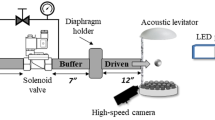Abstract
Using molecular dynamics simulations, the present study investigated the precise characteristics of the binary mixture of condensable gas (vapor) and non-condensable gas (NC gas) molecules creating kinetic boundary conditions (KBCs) at a gas–liquid interface in equilibrium. We counted the molecules utilizing the improved two-boundary method proposed in previous studies by Kobayashi et al. (Heat Mass Trans 52:1851–1859, 2016. doi:10.1007/s00231-015-1700-6). In this study, we employed Ar for the vapor molecules, and Ne for the NC gas molecules. The present method allowed us to count easily the evaporating, condensing, degassing, dissolving, and reflecting molecules in order to investigate the detailed motion of the molecules, and also to evaluate the velocity distribution function of the KBCs at the interface. Our results showed that the evaporation and condensation coefficients for vapor and NC gas molecules decrease with the increase in the molar fraction of the NC gas molecules in the liquid. We also found that the KBCs can be specified as a function of the molar fraction and liquid temperature. Furthermore, we discussed the method to construct the KBCs of vapor and NC gas molecules.













Similar content being viewed by others
References
Aoki K, Takata S, Kosuge S (1998) Vapor flows caused by evaporation and condensation on two parallel plane surfaces: effect of the presence of a noncondensable gas. Phys Fluids (1994–present) 10(6):1519
Baidakov VG, Protsenko SP (2008) Molecular-dynamics investigation of phase equilibrium and surface tension in argon–neon system. J Phys Chem C 112(44):17231
Bird GA (1994) Molecular gas dynamics and the direct simulation of gas flows. Clarendon Press, Oxford
Frezzotti A (2011a) Non-equilibrium structure of the vapor–liquid interface of a binary fluid. In: AIP conference proceedings. American Institute of Physics
Frezzotti A (2011b) Boundary conditions at the vapor–liquid interface. Phys Fluids (1994–present) 23(3):030609
Gu K, Watkins CB, Koplik J (2010a) Molecular dynamics simulation of the equilibrium liquid–vapor interphase with solidification. Fluid Phase Equilib 297(1):77
Gu K et al (2010) Multiscale molecular simulations of argon vapor condensation onto a cooled substrate with bulk flow. J Phys Fluids (1994–present) 22(11):112002
Hansen JP, McDonald IR (1990) Theory of simple liquids. Elsevier, Amsterdam
Ishiyama T, Yano T, Fujikawa S (2004) Molecular dynamics study of kinetic boundary condition at an interface between argon vapor and its condensed phase. Phys Fluids (1994–present) 16(8):2899
Kobayashi K, Hori K, Kon M, Sasaki K, Watanabe M (2016a) Molecular dynamics study on evaporation and reflection of monatomic molecules to construct kinetic boundary condition in vapor–liquid equilibria. Heat Mass Transf 52(9):1851. doi:10.1007/s00231-015-1700-6
Kobayashi K, Sasaki K, Kon M, Fujii H, Watanabe M (2016b) Molecular dynamics simulation on kinetic boundary conditions of gas–vapor binary mixture In: AIP conference proceedings. American Institute of Physics
Kon M, Kobayashi K, Watanabe M (2014) Method of determining kinetic boundary conditions in net evaporation/condensation. Phys Fluids (1994–present) 26(7):072003
Kon M, Kobayashi K, Watanabe M (2016a) Liquid temperature dependence of kinetic boundary condition at vapor–liquid interface. Int J Heat Mass Transf 99:317
Kon M, Kobayashi K, Watanabe M (2016b) Molecular simulation of evaporation mass flux during net evaporation/condensation. In: AIP conference proceedings. American Institute of Physics
Kreider W, Crum LA, Bailey MR, Sapozhnikov OA (2011) A reduced-order, single-bubble cavitation model with applications to therapeutic ultrasound. J Acoust Soc Am 130(5):3511
Kryukov AP, Levashov VY (2016) Boundary conditions on the vapor liquid interface at strong condensation. Heat Mass Transf 52(7):1393–1401
Lee J, Laoui T, Karnik R (2014) Nanofluidic transport governed by the liquid/vapour interface. Nat Nanotechnol 9(4):317
Lu Z, Narayanan S, Wang EN (2015) Modeling of evaporation from nanopores with nonequilibrium and nonlocal effects. Langmuir 31(36):9817
Matsumoto Y, Takemura F (1994) Influence of internal phenomena on gas bubble motion. Effects of thermal diffusion, phase change on the gas–liquid interface and mass diffusion between vapor and noncondensable gas in the collapsing phase. JSME Int J Ser B 37(2):288
Meland R, Frezzotti A, Ytrehus T, Hafskjold B (2004) Nonequilibrium molecular-dynamics simulation of net evaporation and net condensation, and evaluation of the gas-kinetic boundary condition at the interphase. Phys Fluids (1994–present) 16(2):223
Streett W (1965) Liquid–vapor equilibrium in the system neon–argon. J Chem Phys 42(2):500
Streett W (1967) Liquid–vapor phase behavior and liquid phase density in the system neon–argon at high pressures. J Chem Phys 46(9):3282
Taguchi S, Aoki K, Takata S (2003) Vapor flows condensing at incidence onto a plane condensed phase in the presence of a noncondensable gas. I. Subsonic condensation. Phys Fluids (1994–present) 15(3):689
Takata S, Yasuda S, Kosuge S, Aoki K (2003) Numerical analysis of thermal-slip and diffusion-slip flows of a binary mixture of hard-sphere molecular gases. Phys Fluids (1994–present) 15(12):3745
Tsuruta T, Tanaka H, Masuoka T (1999) Condensation/evaporation coefficient and velocity distributions at liquid–vapor interface. Int J Heat Mass Transf 22(42):4107
Tsuruta T, Tokunaga A, Nagayama G (2011) Molecular boundary conditions and accommodation coefficient on a nonequilibrium liquid surface. In: AIP conference proceedings. American Institute of Physics, vol 1333, p 859
Wörner M (2012) Numerical modeling of multiphase flows in microfluidics and micro process engineering: a review of methods and applications. Microfluid Nanofluid 12(6):841
Xie JF, Sazhin SS, Cao BY (2012) Molecular dynamics study of condensation/evaporation and velocity distribution of n-dodecane at liquid–vapour phase equilibria. J Therm Sci Technol 7(1):288
Acknowledgements
This work was supported by JSPS KAKENHI Grant No. 16K06064. Many people, especially Dr. H. Yaguchi (National institute of technology, gunma college), Mr. T. Yahagi, and Mr. K. Hori, have made valuable comments and suggestions.
Author information
Authors and Affiliations
Corresponding author
Rights and permissions
About this article
Cite this article
Kobayashi, K., Sasaki, K., Kon, M. et al. Kinetic boundary conditions for vapor–gas binary mixture. Microfluid Nanofluid 21, 53 (2017). https://doi.org/10.1007/s10404-017-1887-6
Received:
Accepted:
Published:
DOI: https://doi.org/10.1007/s10404-017-1887-6




